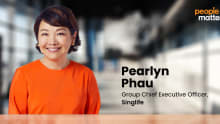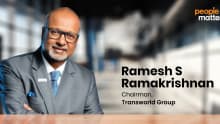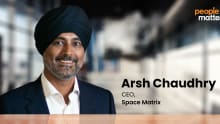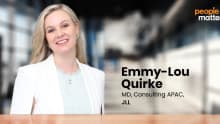Data, tech, and the human touch: JLL's Emmy-Lou Quirke on redesigning offices

The remote work revolution sparked by the pandemic has fundamentally altered our relationship with the office. The future demands flexible, well-equipped environments that seamlessly support both our personal and professional needs. Emmy-Lou Quirke, JLL's Head of People Experience, shares her vision for this workplace transformation and why putting people first is the key to attracting and retaining top talent in today's dynamic business world.
With a unique background spanning health, management consulting, clinical science, and engineering, Quirke brings a multi-faceted perspective to her work. This informs her passion for data-driven innovation, digital transformation, and human-centred business design.
Here are the edited excerpts.
Your role isn't traditional HR, but it intersects with it. Can you elaborate on this intersection and how it contributes to the larger oragnisational role?
Emmy-Lou: My role is focused on advising clients about emerging workforce trends, transformation strategies, and employee wellbeing. The cornerstone of this work is recognizing that people, who utilise our offices and shape our cities, should be at the center of every design decision. Cities and offices exist to serve people – a truth the pandemic brought sharply into focus. At JLL, we're proactively integrating lessons learned from the remote work shift. Our goal is to ensure offices offer compelling value by intentionally designing them to meet the dynamic needs of today's workforce. We're committed to applying these insights to actively shape the future of work.
ALSO READ: Tech titan Guy Kawasaki on growth, grit and grace
Mastufa: You've mentioned the importance of workplaces adapting to the needs of employees. How do you see the future of work today globally and specifically in Asia?
Emmy-Lou:I think the future of work, especially in Asia, lies in the synergy between technology and human-centric workspace design. While early discussions about AI focused on job replacement, we're seeing it enhance our roles. Tools like ChatGPT streamline information gathering and expand our thinking, revolutionizing knowledge work.
Simultaneously, there's a growing emphasis on the physical workplace. We're analyzing how people interact with these environments, prioritizing health and well-being. This means creating spaces for both focused work and quiet reflection, recognizing the importance of neurodiversity, mental health, and overall well-being. Factors like air quality and even flexible desk arrangements are becoming essential for an optimal work environment.
Mastufa: With many championing the hybrid model as the future of work, what strategies would you suggest for an effective hybrid workplace?
Emmy-Lou: The last few years have shown us the viability of hybrid work for certain roles. However, optimizing it requires a thoughtful approach. Here's what I believe is crucial:
Empower with Choice: Neuroscience research suggests that choice over work environment boosts performance and job satisfaction. Enable employees to choose between their home environment for focused work and the office for collaboration, fostering better outcomes.
Balance Needs: Design a variety of workspaces – some geared towards collaboration, others designed for quiet, focused work. Avoid the assumption that everyone wants an entirely collaborative office. Technology can facilitate this, helping people find the right space or know when colleagues will be on-site.
Invest in the Office: To make the office a compelling choice, it needs to surpass home setups. Provide seamless technology, ergonomic workstations, and a comfortable environment
Data, Not Assumptions: Understand your unique workforce through surveys and data analysis. Avoid a one-size-fits-all solution, and design a hybrid model that addresses their specific needs and pain points.
Mastufa: Return-to-office trends vary significantly across the APAC region. Can you elaborate on this and explain how factors like commuting and living space contribute to this variation?
Emmy-Lou: In densely populated cities with convenient public transport, like Singapore or Tokyo, office environments are often favored. This is due to smaller living spaces where employees struggle to find dedicated work areas at home. In contrast, regions with longer commutes and larger living spaces, like parts of Australia or the US, see a greater preference for flexible work arrangements.
The core purpose of a company also significantly impacts its approach. Financial and trading firms typically require the in-person dynamics that an office fosters. Tech companies, on the other hand, may prioritise in-office collaboration for specific roles, but also recognise the value of remote work in attracting talent.
Mastufa: You mentioned the importance of data in workspace design. Tell us how data can inform the creation of environments that truly nurture employee happiness and innovation.
Emmy-Lou: There's no one-size-fits-all optimal office design. The best approach is highly customised, and a key part of our work now involves 'work science.' This approach merges data analysis with workplace design to understand a company's unique needs and support innovation.
We factor in everything: company purpose, business model, specific employee requirements, and the tasks that benefit most from in-person work. For example, financial services firms might need high-quality, almost 'executive club' style spaces for impactful client interactions. Tech companies, on the other hand, could benefit from spaces designed for collaboration and knowledge-sharing.
The bottom line is this: data gathering, thoughtful analysis, and alignment with company goals are essential for creating an office that genuinely drives employee happiness and fuels innovation.
Mastufa: For a CEO navigating these changes, what are the most crucial factors in designing a workspace optimised for employee experience?
Emmy-Lou: There's a clear emphasis on quality over quantity. Companies are often downsizing in terms of square footage, but they're investing in higher-quality amenities, meeting spaces, and seamless in-office technology.
Flexibility and agility are also paramount. The design should support activity-based working, allowing employees to move between zones based on their tasks. Adaptability for future shifts in how we work is important as well. Using technology as a tool for proactive facilities management can greatly enhance the employee experience. Sensors and predictive analytics can streamline cleaning schedules, meeting room management, and other factors which all contribute to a more positive workplace environment overall.
Mastufa: What are the top two office design challenges your clients face, and what strategies do you recommend for overcoming them?
Emmy-Lou: We view office design as a strategic tool for attracting and retaining top talent. Our award-winning Tokyo office demonstrates this – an internal study revealed significant improvements in employee performance and well-being after moving to the new space. Key design elements that contributed to this success include biophilic design, sensory balance, varied workspaces, seamless technology and localisation.
Key challenges include finding the right mix between physical spaces that encourage in-person interaction and flexible arrangements that support individual work and remote employees. Designing with agility in mind, knowing workplaces now need to seamlessly integrate with emerging technologies, including AI tools. Moving beyond perks and amenities to consider the built environment's impact on mental and physical health.
As younger generations enter leadership, we're seeing major shifts. They crave flexible, collaborative workspaces that support DIY approaches. The traditional corner office won't cut it anymore.
The future belongs to companies that prioritise connection and belonging. While perks and amenities matter, a strong culture that fosters a sense of purpose will be the ultimate competitive advantage.
Mastufa: The rise of AI, particularly gen AI, is rapidly changing the workplace. How do you envision this technology transforming the employee experience?
Emmy-Lou: I see a growing trend towards hyper-personalisation, fueled by AI and other technologies. This ability to tailor experiences, from scheduling preferences to information delivery, reflects what we're used to as consumers.
AI tools such as chat platforms are putting us in the driver's seat, giving us greater control over the information we access and how we process it. People want authenticity and want to see how others genuinely interact with products and brands.
Mastufa: As we wrap up, what is the single most important piece of advice you would offer HR leaders?
Emmy-Lou: Remember, even as we embrace technology to streamline and enhance processes, the most valuable asset remains your people. It's the human connections, empathy, and the ability to inspire that ultimately drive exceptional performance.
While compliance, regulations, and business goals are crucial, don't lose sight of the fact that you're working with humans. Prioritising their needs and experiences will always be the key to creating a truly successful and resilient organisation.




